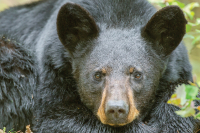Wandering elk in Nantahala falls victim to wildlife ‘stand your ground’ rule
 A property owner in the remote Nantahala area of Macon County shot an elk that was eating his corn, upsetting neighbors who liked having an elk among them.
A property owner in the remote Nantahala area of Macon County shot an elk that was eating his corn, upsetting neighbors who liked having an elk among them.
“It is not right for one person to deprive everybody else the natural beauty of these animals,” said Shirlan Haney, who lives on Nantahala Lake.
The elk had wandered far from the established elk herds in Haywood County and Cherokee, but it’s not uncommon, especially for young male elk, to roam. This one — which Haney and her neighbor named National Velvet for the velvet on his young antlers — had found quite a fan base in his adopted home.
Sid May said the elk caused a traffic pile-up in front of his house one day, albeit only three cars, but a traffic jam by Briartown standards.
“It reminded me of a movie star just standing there for the camera,” May said. “I have heard a couple people say ‘Well, hey, if it was destroying all his corn I don’t blame that guy for killing it.’ But the majority said it is really a shame they killed that one. It could have destroyed all my corn and I wouldn’t have killed it. For most of the people in my community, that is their feeling, too.”
It took several days for word of the elk shooting on Aug. 15 to spread outside the isolated Nantahala community and circulate through the county, eventually get tipped to media outlets, which in turn started asking questions of the N.C. Wildlife Resources Commission.
Related Items
The top thing those who’d become fond of the Nantahala elk wanted to know: was it legal for the property owner to shoot it?
“If an animal is caught in the act of depredation it can be shot and killed and the land owner exercised that right,” explained Justin McVey, a wildlife biologist with the wildlife commission who covers the western counties, and frequently deals with elk management issues.
The wildlife commission so far won’t release the identity of the person who shot it. It happened in the Tellico area of Nantahala.
Two elk have been shot in recent years by a dairy farmer in Haywood County, where reports of nuisance elk have mounted as the initial herd introduced in the Great Smoky Mountains National Park there has expanded onto private land.
While McVey said it’s legal under state statute for property owners to shoot wildlife caught in the act of property damage, it is frowned upon. McVey’s first advice to landowners with elk run-ins: haze them with pepper spray or run a couple strands of electric fence.
Elk are considered a species of special concern, and if landowners are too hasty in hauling off and shooting one for merely nibbling their ivy, they could run afoul with the law.
The wildlife commission’s website tells landowners to get a depredation permit before dispatching species of special concern, first providing evidence the animal has caused property damage.
The Macon County landowner had talked to wildlife officers about the elk, but didn’t get a depredation permit before shooting it. While it’s preferred, it’s not necessary under state statute.
“No depredation permit or any license is needed…to take wildlife while committing depredations upon the property,” state statute reads. One benefit to getting a depredation permit first is being able to keep the meat.
The wildlife commission’s law enforcement branch is reviewing the Macon elk case to determine whether the shooting was warranted under the law, according to Geoff Cantrell, spokesperson for the wildlife commission in Raleigh.
McVey said there were obvious signs of damage to the corn, and a necropsy of the elk carcass proved what the elk had been up to.
“His stomach was full of corn,” McVey said.
Elk on the move
Elk were first reintroduced in the Cataloochee area of the Great Smoky Mountains National Park in Haywood County 15 years. They multiplied substantially — from 50 initial elk to somewhere between 200 and 300. More than half now reside outside the park, primarily in Haywood County, but also in Cherokee.
Despite occasional elk sightings further afield — from Glenville in Jackson County to Shooting Creek in Clay County — the N.C. Wildlife Commission doesn’t believe that the lone elk sightings in Nantahala are a sign of a herd establishing there.
The elk that was shot in Macon County was a two-year-old male elk. Younger male elks are particularly prone to wander, particularly during summer, but often regroup with their home herd in Cherokee or Haywood County when the mating season — known as the rut — gets under way in early fall.
“I have seen them disperse and go out during the summer, then come back,” said McVey.
It’s unlikely the elk sightings in Nantahala are a harbinger of a permanent elk herd there.
“There are still a lot of places to eat and hang out between Haywood County and Nantahala,” McVey said.
Residents in the Nantahala area of Macon County believe there were at least two, maybe three, elk living among them, based on different pictures and videos people have captured.
Shirlan Haney said she didn’t believe her neighbors at first when they told her they’d seen an elk.
“I didn’t know what to make of it. I said ‘You probably saw a great big deer,’” Haney recounted. Until one morning in July, she was sitting on her deck looking out at the lake and she saw it.
“It was one of the most gorgeous pictures I had ever seen in my life. It was like something from National Geographic. I thought ‘oh my goodness I live in paradise,’” recounted Haney.
A fisherman was in a boat on the lake, and she wanted to tell him about the elk, but didn’t want to scare it away. So she started jumping up and down to get the fisherman’s attention, holding her arms up over her head like antlers and pointing to the elk.
“I was whispering ‘there’s an elk!’ like he could read my lips down there on the lake,” Haney said.
Next, she ran to her neighbor’s house, who was brushing her teeth at the time, and told her to put down the toothbrush and grab her camera.
The elk didn’t seem the least bit afraid of them as it wandered around her yard, and passed within feet of them, sniffing her barrel of mint as it came up the driveway.
“With God as my witness I could have put a saddle on that elk and rode it. I respected it as being a wild animal but I had no fear of this animal whatsoever,” Haney said.
A few weeks later, Sid May got a glimpse of the elk over in Briartown when it came to sample the wares of his apple trees one afternoon.
“It just walked up and stretched its big long neck out.
It made a good dinner out of them,” May recalled.
May watched it for about 15 minutes before it ate its fill and wandered off.
Around dusk that same day, May had what he calls a “bout with a black bear.”
A bear with four cubs came up on his porch, apparently after a 40-pound tub of birdseed.
“It wanted to take that container, but I yelled at it and it made all kind of noise and it growled at me,” May said. “While all this commotion is going on with me and my bear, there were three cars stopped on the road in front of my house. The bear got scared and it took off, ran across the road right in front of these three vehicles and this lady says to me ‘Sid, Sid, look down the road’ and there’s that elk.”
No boundaries
When elk were first introduced to the Smokies, the national park rounded up wayward elk and brought them back to Cataloochee.
But as the elk population grew, more and more pushed beyond the borders of the national park, and keeping them contained became impossible.
To sightseers, the elk are stately and placid creatures.
But to those who’ve had elk take up residence in their yards, cow pastures and crop fields, elk are a nuisance.
And to farmers, they eat into their living — literally.
Since the park reintroduction, elk management has been foisted on the N.C. Wildlife Resources Commission by default. Residents in the Nantahala area have questioned whether the wildlife commission has an adequate or clear policy on how nuisance elk should be handled by property owners.
But the wildlife commission has no control over the state law that allows property owners to shoot wildlife for damaging property, and can only encourage and recommend other approaches.
“Aversive strategies often resolve conflicts negating the need for lethal removal,” according to Cantrell, spokesman for the wildlife commission.
The elk shooting in Macon County isn’t the first time farmers have retaliated against the elk.
Early during the elk introduction, a dairy farmer in Haywood County shot an elk that kept coming onto his dairy farm.
A few years later, two depredation permits were granted by the wildlife commission to farmers in Haywood County — one was the same dairy farmer who’d had problems before and one was a crop farmer who had his pumpkin patch repeatedly smashed and trampled by an elk.
Aversive conditioning carried out with help from the wildlife commission — namely staking out the pumpkin patch and firing a loud flare gun at the elk — scared it enough not to come back, so he never had to pull the trigger on the depredation permit.
McVey said the Macon County property owner was offered strategies to keep the elk at bay. His best bet would have been an electric fence known as “polytape” — which has electric wires encased in a 2-inch-wide white ribbon. It can be tacked to stakes or fence posts without the need for a full-blown fence, McVey said.
The wide, white strips of polytape are more visible to elk than traditional electric fence wires. After being shocked once, the elk are more likely to recognize the polytape as something not to go near again.
“It has been pretty effective it seems like,” said McVey. “It is a fence that won’t necessarily break the bank but will persuade the elk to go the other way. A lot of it is just a psychological barrier.”
Another option for deterring nuisance elk is “aversive conditioning.” Pepper spray is the main do-it-yourself option, McVey said.
All this begs the question, however: why should farmers bear the added headache to keep these newcomers away from their crops? The farmers were here first, and are now dealing with a nuisance species they didn’t ask for.
“That is a valid point and tough question to answer,” McVey said. “It is what it is. There is no point in arguing about why they were reintroduced. They are here. They are part of the landscape now and we have to deal with it.”









